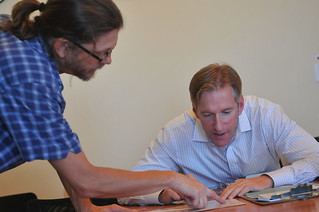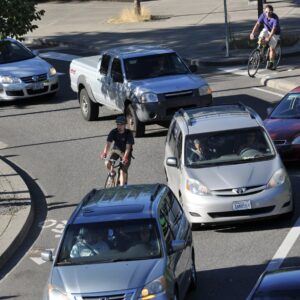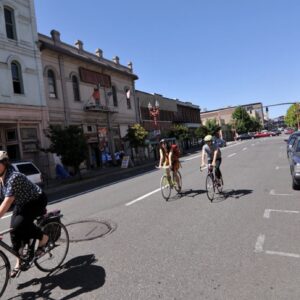
network of neighborhood greenways in southeast Portland
that was introduced to him by volunteer activist
Terry Dublinski-Milton.
(Photo © J. Maus/BikePortland)
If you have aspirations to be mayor of Portland, you must know your way around cycling issues.
That fact was cemented yesterday when mayoral candidate Ted Wheeler sat down for a meeting with cycling advocates just one day after he officially announced his campaign. The meeting was organized by his staff several weeks ago as a simple informational session to help the current State Treasurer bone-up on bicycling.
Here’s who Wheeler met with for just over an hour at the central eastside office building of Alta Planning + Design: (Disclaimer: Alta offered to host. Wheeler’s staff asked me who should attend and I gave them a list): Terry Dublinski-Milton from SE Uplift and BikeLoudPDX; Alta Planning’s CEO Mia Birk; Ian Stude, Director, Transportation and Parking Services at Portland State University; and yours truly. (Others invited to the meeting but who were unable to attend were: Alta Planning Principal and Program Specialist Jessica Roberts; Carl Larson from the Bicycle Transportation Alliance; founder of Rosewood Bikes Matt Martin; and citizen activist Lizbon Grav.)
“I want to hear what people are thinking and what you expect from the next mayor of Portland.”
— Ted Wheeler
Wheeler made it clear from the outset that he was flexible about the format, but his intention was to learn and ask questions. “I’m not coming here in the spirit of, I know it all and here’s my plan for bicycles,” he said. “I’m not in a position to be telling people how it is in their particular space… I want to hear what people are thinking and what you expect from the next mayor of Portland.”
We spent much of the time talking about the Bureau of Transportation’s neighborhood greenways program. Dublinski-Milton, one of the most dedicated and knowledgeable volunteer advocates I’ve ever met, started things off by sharing his vision for “Southeast in Motion” a network of low-stress residential streets in southeast Portland. He’s modeling his work on previous neighborhood planning efforts that PBOT has adopted like Southwest in Motion and East Portland in Motion.
Advertisement
Wheeler was very intrigued by Dublinksi-Milton’s concept and impressed by the work he’s put into it (we all were) — so much so that he gave Dublinski-Milton his personal email address to follow up. After taking a close look at maps and other documents related to the plan, Wheeler asked us his first question: “What can you tell me about the cost of these greenways?”
“What do you think is the best opportunity and what is your biggest fear?”
— Ted Wheeler
At that point Mia Birk gave him some background on what they were and some cost estimates for how much they cost. Once he got a better picture of neighborhood greenways in his head, he said, half-jokingly, “So, we get a High Line on street level?” Wheeler was referring to the High Line linear park that winds its way through Manhattan on what used to be an elevated subway line.
The conversation then shifted toward the key challenge for neighborhood greenways: diversion. Wheeler was a quick study on the topic and seemed to immediately grasp the neighborhood dynamics and politics around this issue. He actually said it was similar to his work on the Columbia River Crossing (but on a much different scale) when he crunched numbers on capacity of the highway expansion and its potential impact to nearby neighborhoods and other freeways.
Ian Stude from PSU then pointed out to Wheeler that, while greenways are great, they are just a small step towards what’s needed to achieve our biking goals. To really move the needle, Stude said, we need protected bikeways on major streets.
A conversation about the benefits, tradeoffs, local history, and politics of physically protected bikeways ensued.
“Where would be your top locations for these?” Wheeler asked. And without skipping a beat, Dublinksi-Milton, who was standing at this point and speaking in his usually passionate and demonstrative way, said, “Burnside. Barbur. 122nd.” Stude threw in Broadway for good measure.
With all these big ideas on the table, the rest of the meeting was spent sharing our various perspectives on why Portland hasn’t moved forward on major protected bikeway projects at the rate of other cities. We talked about a lot of reasons: funding constraints and the need for a new local revenue source; the bad bike politics that have plagued Portland since the scandal that nearly brought down former Mayor (and biking champion) Sam Adams in 2008; the unfortunately large influence wielded against City Hall (and PBOT) by the Portland Business Alliance and other groups; a local media that’s often hell-bent on sensational and controversial coverage when it comes to bicycle projects and policies; and so on.
Bicycling is such a positive for the city, there’s absolutely no reason it should be controversial. Or expensive. To make a point about funding, I asked Wheeler if he’d ever been to Sunday Parkways. “What’s that?” he asked. I explained all the amazing benefits Sunday Parkways has brought to our city and pointed out that it does so at a very small cost. We have so much road real estate right now, I shared, we just choose to let it be used primarily for driving. There are many low-cost steps we could take to re-allocate space and create the physically separated conditions so many Portlanders — on both sides of the windshield — crave.
Toward the end of the meeting Wheeler asked us all to answer one final question: “What do you think is the best opportunity and what is your biggest fear?”
We answered the first part by sharing our hopes for stronger political leadership around active transportation (that was a major theme the entire meeting) and a future that includes a network of protected bikeways.
In terms of our biggest fears, the funding problem came up again; but I think the most powerful answer was summed up in three words: business as usual.







Thanks for reading.
BikePortland has served this community with independent community journalism since 2005. We rely on subscriptions from readers like you to survive. Your financial support is vital in keeping this valuable resource alive and well.
Please subscribe today to strengthen and expand our work.
“So, we get a High Line on street level?”
I wish our neighborhood greenways lived up to this placemaking potential (but perhaps with a bit more mobility focus than the High Line has.)
I hope the central city Green Loop concept can really take mixed traffic environments to a new level to show what a park-like residential street designed for biking and walking can really look like.
I think Terry’s vision for neighborhood greenways has more placemaking potential than our current version. He’s talking diversion every ~5?(Terry, please correct?) blocks. Ideally, those diverters could be placemaking “nodes” with benches/nice planters/chalkboards/whatever integrated into the design.
yep Alex, and terry actually shared more about that. We talked about the pocket park at Holman/13th as an example of what we could/should do a lot more of.
As someone who has lived on the intersection of RPW and Durham, I can attest to the efficacy on calming traffic significantly and curbing the volume of cut-through traffic. It turned a dangerous side street into a livable one over night.
He did seem to understand the need for diversion, and immediately integrated the Pocket Park” concept on greenways for neighborhoods that are under-served with poor park access.
Thanks Terry D-M! Everyone else at the meeting is getting paid one way or another (maybe not enough, but some) for the time they invest making things better, but as far as I know Terry is strictly a volunteer. He’s already made a noticeable difference in his home neighborhood of North Tabor and is working hard pushing ideas that will make a big difference in a whole swath of mid-eastside neighborhoods in the 40’s-80’s.
You are welcome, and thank you for the great complements!
for the sake of clarity… just want folks to know i just added this paragraph toward the end of the story:
Yes!
I’m surprised Wheeler has not heard of Sunday Parkways!
Yeah, he must be really absorbed in Salem to not know. That being said, how many people who live in Southwest Portland do?
True! The SW Portland residence of many city leaders is a big problem for understanding the rest of the city.
Terry is a force to be reckoned with. Glad the meeting happened and all you smart people were in the room.
The bta could not make it?
I thought that was odd, I had plenty of lead time to prepare.
I think Carl is out of town.
I’m out of town and even if I wasn’t, my attendance would not have been as a BTA representative. As a 501(c)(3), the BTA is legally restricted from being involved with many aspects of electoral politics.
Way to preach the bike advocacy gospel, Terry.
“Burnside. Barbur. 122nd.” Stude threw in Broadway for good measure.
And Sandy!
And Holgate! 🙂
Sandy deserves mention; it would complete the SW to NE diagonal route, along with SW Barbur, and continues into northern East Portland.
And don’t forget Powell, Naito (and NW Front), and Lombard! Adding those would include a major street in every quadrant.
Barbur is good, but it straddles the borders of NW and SE.
Seems like Wheeler’s relationship with bicycles as a politician isn’t too different from his relationship with bicycles as a triathlete. Better hope his policy doesn’t contain any steep hills or sharp curves.
I started out as a triathlete and now I consider myself a bike advocate so there’s hope yet. Don’t discount the power of the amateur racing scene to attract people to the biking world.
Thanks for the complements everyone!
Why yes Jonathan, I have a “passionate and demonstrative way” when I speak….my friends have been making fun of me for many years, but it makes me memorable.
It was a great meeting, and I hope a lot of good things come of it.
Ugggh 122nd is pure hell and seems without hope, but I’m glad to see Terry mentioned it!
122nd is not that hard. Most of the 5 lane sections with bike lanes and roadside parking are not that hard. Remove the curbside through lane and change it to parking. Change the bike lane to a buffer. Change the parking lane to a bike lane.
Great work! I pay attention to bicycling issues citywide and the issues are different in different parts of town. SW Portland is different from Portland east of the river, but there is a lot of potential to increase cycling in SW Portland if there were safer facilities on the busier streets that connect with key destinations. Barbur, Capitol Highway, Taylors Ferry, Boones Ferry, Terwilliger, Pomona, Stephenson, 35th, Hamilton, Dosch, Shattuck and Sunset are just a few. Today Beaverton-Hillsdale Highway and a section of Multnomah Blvd have the best bike lanes in SW, but we need more protected bike lanes on busy streets to make it viable to get around safely on bike.
Regarding Sunday Parkways, there were two events in SW in 2012 and 2014 (the 2013 event was cancelled due to weather). I sent this note to Linda Genenthal reflecting on the Sept 28, 2014 event in SW: “BikePortland had an excellent blog about how to bring new events like educational seminars to the event. One seminar that is definitely needed is “how to tackle biking the hills”–not just for Sunday Parkways but for other interested-but-concerned cyclists as well. Many people were unprepared for the hills and needed frequent rests. It was especially hard for the younger kids on training wheels or those not strong enough to brake on the downhills. Unfortunately, the flattest streets in SW Portland are the arterials and Sunday Parkways tries to avoid arterials. I also heard people ask why it wasn’t a loop and I explained that there were worse hills on the route two years ago that were taken out this year.”
There are two projects in the city’s Capital Improvement Plan that will improve bicycling in SW Portland (Barbur Demonstration Project (19th-25th) and a portion of the Red Electric Trail near Hillsdale), but that’s a drop in the bucket compared to what’s needed to encourage more people to ride a bike in SW Portland.
Sunday Parkways needs to bite the bullet and open arterials to the people. On the east side, residential streets are way too narrow for the volumes that bike on Parkways days. I hadn’t realized the hilly residential street obstacle on the west side, but it makes perfect sense now that you point it out. Lots of other cities (LA, Bogota, Minneapolis, …) route on major streets and it just seems like it would work better. The City needs to stop being so afraid of bikelash. The advocacy community has their back now!
I’ve spent time and done lots of scouting to find alternate ways to get around what’s in my opinion a higher stress part of Barbur than the two bridges. The stretch between the intersection of Bertha and the I-5 on/off ramp and Terwilliger has given me quite a few close calls with motorists coming off the freeway. The high volume of traffic in that area during peak times is off-putting and I’m surprised there aren’t more accidents. The area is actually pretty heavily used by bikes. During one rush hour, I counted at least a dozen bikes all at the intersection of Terwilliger and Barbur waiting during a light cycle. Corbett is a decent enough alternate but the hills are pretty gnarly. The southbound stretch between Nebraska and California streets is a killer!
I think the work done on Multnomah Blvd a couple years ago was a missed opportunity. The bike lane on the north side of the road is decent enough. There’s a slight lip between the road and the bike lane and the use of concrete gives a big visual cue that the bike lane and the road are separate. Reversing the position of the parkstrip/swale setup with the bike lane would have been stellar, especially since traffic on Multnomah moves pretty fast. The bike lane in that case could have been raised or sunken to provide some physical separation with the sidewalk. The south side of Multnomah got no love, however. The treatment on the north side, while not ideal, could have been just a bit wider and allowed for a two lane, separated bikeway. If ifs and buts were candy and nuts I suppose…